
I may or may not have been right in guessing that the Soviet Union was the pretend enemy in the 1928 RAF Display set-piece, but as we shall see I think I’m on safer ground with the next year’s edition (for some reason held slightly later in the summer than usual, on Saturday, 13 July 1929). The tenth ‘Grand Finale or Set Piece’ had an unusually elaborate geopolitical backdrop and an unusually elaborate set.1 The scene was ‘Hendon Sea Port’ AKA ‘Hendon-by-the-Sea’, which
represented a foreign defended port overseas, and consisted of a harbour with a quay terminating at a fort at the seaward extremity and various buildings at the landward end. Alongside the mole with waves rippling against its sides (these waves, by the way, were the silk of old parachutes, pegged to the ground and fluttering in the wind), was an imposing troopship, with smoke already issuing from its black and orange funnels; troops were embarking and stores were being transferred from lorries.
Outside the harbour various vessels, complete with waves, cruised about, while other craft, including an ammunition lighter, were anchored inside. This was the “peaceful” but active scene we looked upon at the start, and one could hardly believe it was not real.2
It’s clear that the RAF put a lot of effort into these sets which were destined to be blown up (see the British Pathé newsreel above), even allowing for the fact that they were built from scrap metal and old parachutes.

This attention to detail was matched by the plot:
The British Government was in diplomatic correspondence with this foreign power in relation to the disputed boundary of a British overseas possession, and had referred the question to the League of Nations. Without waiting for the report of the League of Nations, the foreign Power committed a definite act of aggression against this country, and intelligence reached the British Government that following up this act, the foreign Power was despatching an expedition from the port against British territory.
As a result, the Government despatched a force of heavy bombers, together with an aircraft carrier, to British territory within range of the port to resist the despatch of the expedition.3
That’s a lot for the watching public to soak in, and it’s quite possible that they didn’t and instead merely enjoyed the spectacle. This included: an Atlas army co-operation aeroplane reconnoitring the port and radioing back target information (and providing loudspeaker commentary for the crowd); the obligatory launching of an enemy observation balloon; and the equally obligatory shooting down of said balloon, on this occasion by carrier-borne Fairey Flycatchers which then proceeded to strafe the port.
A squadron of enemy fighters (“Siskinskys”) next arrived, and matters began to get exciting, for in the distance we saw a squadron of British bombers [Hyderabads] approaching in formation. Before they got over the harbour the enemy fighters attacked, resulting in losses on both sides — but the bombers got in a few “pills” with good effect.4
So ‘Siskinsky’ = faux Russian for Armstrong-Whitworth Siskin, which seems to identify the enemy here pretty clearly. After a bit (or a lot) more of this, the RAF gained air superiority, following which a squadron of Fairey IIIFs ‘neatly tidied up the port, including transport, mole, and buildings, and then gracefully retired’.5 Finally, an enemy ‘ship’ entered the harbour then retreated, laying a smoke screen for cover and drawing a curtain over proceedings. All in all, this set piece involved elements of seven squadrons (plus the School of Balloon Training) and must have been the biggest to date.

For some reason the set-piece for the eleventh RAF Display, held on Saturday, 28 June 1930, substituted the gritty realism and excitement of failed arbitration by the League of Nations with pirates! Yes, pirates! Flight described the plot as ‘almost Edgar Wallacey — but not quite’:6
These pirates, the crew of a vessel carrying munitions and aircraft, had seized the ship and taken refuge in a sparsely populated part of British Colonial territory. Having installed themselves in a planter’s house (and murdered the planter and his staff!) they proceeded to erect the stolen aircraft with the intention of conveying (and ultimately disposing of) the booty to various destinations.7
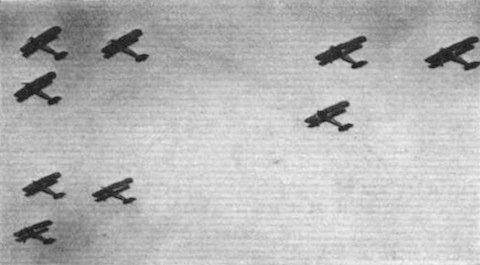
The RAF is sent in to put a stop to this with a mixed force of fighters, bombers (the Horsleys are seen above), and troop carriers.
As one of the pirate aircraft (impersonated by “Hyderabads” from Nos. 10 and 99 Bomber Squadrons) took off, the British fighters appeared on the scene and attacked the pirate aircraft in the air and on the ground. As a result some of the pirates forthwith surrendered, rushing out into the open and waving white flags.5

Bombers ‘effectively destroyed’ the remaining buildings, after which ‘the troop carriers (Victorias, above) arrived and deplaned a small force of irregular regulars, who made prisoners of the surviving pirates and recovered the booty’.5 I’m not sure that the possibility of air piracy was really something the Air Staff had ever given much thought to; but really this is pretty much one of the earlier air control set-pieces with a fantastic scenario slapped over the top.
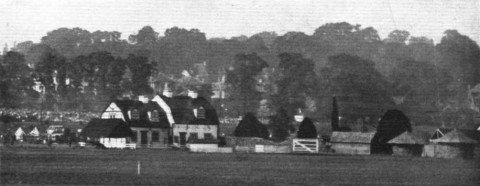
The next RAF Display was held at Hendon on Saturday, 27 June 1931. Flight seems to damn the set piece with faint praise, calling it ‘a straightforward story well told’.8
War had broken out, and a long-range gun — Big Bertha’s little sister — was cleverly hidden amongst deserted farm buildings alongside a small wood, together with shelters, ready-use ammunition dumps, decauville [sic] railway, etc. This gun has been shelling an important military base, which it threatened to make untenable. Its position, however, was discovered, and a bombing attack was prepared to destroy it.5
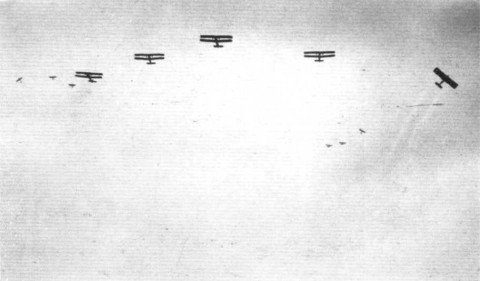
The story is straightforward. The defences consist of two fighter squadrons (both with Siskins) and an anti-aircraft battery. Interestingly, the attacking bombers (Hyderabads — above — and Harts) have no fighter escorts, but despite some losses still manage ‘to unload their missiles and complete the destruction of Big Bertha’s little sister, the ammunition dump, the farm and Uncle Tom Cobly and all’.5 The clearly European setting is also intriguing; perhaps increasing instability in Germany made another nearby war seem more likely. Or maybe it was just Europe’s turn for a Hendon set-piece again.
![]() This work is licensed under a Creative Commons Attribution-NonCommercial-NoDerivatives 4.0 International License.
Permissions beyond the scope of this license may be available at http://airminded.org/copyright/.
This work is licensed under a Creative Commons Attribution-NonCommercial-NoDerivatives 4.0 International License.
Permissions beyond the scope of this license may be available at http://airminded.org/copyright/.

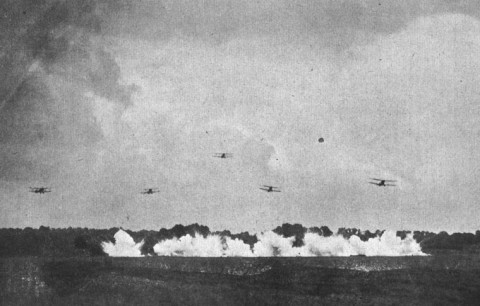
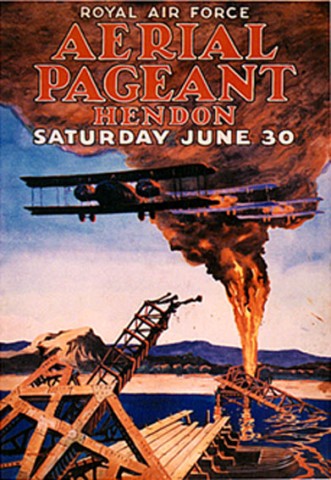
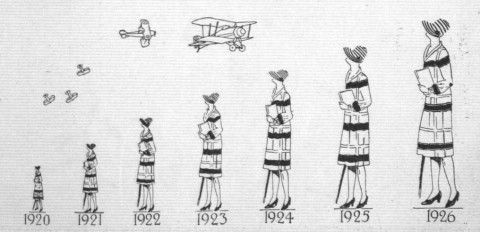
When I see ‘RAF sinks ships’ I think ‘RAF having a spat with the RN’. Is the timing right for that in 1929?
The 1930 Air and Army Exercises also had elaborate, nonconfrontational scenarios. In both cases (I think –my recollection of the Army exercise is particularly weak), pitting the armed forces of “independent former European colonies” in distant parts of the world against each other.
I was given to understand by various talking heads that this was at the behest of the Labour government, for the usual reasons. It’s a pity that the precedent wasn’t continued. The Air Exercises in particular sounded like a lot more fun than the usual “knock-out blow” against London.
Pingback: Airminded · Ending Hendon — V: 1932-1934
Chris:
I don’t think there was any specific RAF-RN tiff in 1929 but then I don’t think they ever needed an excuse! On the other hand, even though the FAA was technically RAF the inclusion of an aircraft carrier in the scenario does suggest — at least as far as propaganda was concerned — that there was a place for the RN in the next war.
Erik:
That’s interesting. I wonder if the 1929 scenario, with the stuff about the League and so on, was aimed at the new Labour (and hence pro-Geneva, collective security, disarmament) government. Sort of saying, hey look, we’re not just useful for imperialism! But the timeline is tight. MacDonald took office on 5 June 1929, which is only 5 weeks before Hendon. On the other hand, as I note above the Display was a couple of weeks later than usual, perhaps the election did delay it. The scenario background could have been cooked up after the election anyway, even after the form of the set piece itself had been decided on. And maybe, as you say, the Labour government had a hand in setting the backstory. Somebody must know this stuff.
I may do a series on the annual air defence exercises (1927-1933 from memory) as they were very public too, though more as media events than public spectacle.